Help! My Baby Won’t Take a Pacifier
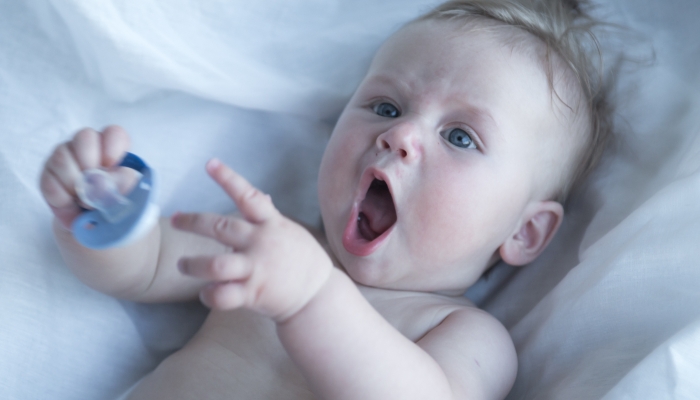
- Many babies love pacifiers as they help with sleep, can relieve ear pain and pressure, and reduces the risk of SIDS.
- Pacifiers help to soothe colicky newborn babies and provide a useful distraction for shots and doctor visits.
- Many parents prefer pacifier use because they’re disposable, making it an easier habit to stop than thumb-sucking.
- Some children can become dependent on pacifiers which can misalign your baby’s teeth.
- Pediatricians recommend using pacifiers primarily for tired and colicky babies and waiting until your baby is at least 3-4 weeks old before introducing one to avoid nipple confusion.
- To get your newborn baby to try a pacifier for the first time, introduce it for fun, between a feeding session or before nap time.
- Never force your baby to take a pacifier. If your baby is resistant to taking one or spits it out, leave it and try another time.
Many parents want to take advantage of the soothing and sleep-inducing benefits of using pacifiers during the first year of infancy.
Some babies spit out, reject, or have aversions to taking pacifiers, which can be frustrating and confusing for fussy babies and their parents. This is completely normal, and not all babies will take a pacifier.
We’ll discuss how you can get your baby to take a pacifier for parents who would like to benefit from some of the ways pacifiers can help soothe young babies.
There are common reasons why your baby rejects his pacifier and techniques you can try to get him to come around. Also, we’ll give you alternatives to comfort your baby if he’s not taking a pacifier yet.
Advantages of Using a Pacifier
When introducing a pacifier to your baby, there are pros and cons to consider.
Pros:
- Helps with sleep: Parents love that pacifiers help babies fall asleep fast. If your baby has trouble settling down, is colicky, or you’re trying to break the habit of nursing or giving a bottle to your baby to sleep, a pacifier could be the solution.
- Relieves ear pain: Pacifiers are wonderful for flying and travel. Babies don’t know how to “pop” their ears, so sucking on a pacifier helps to relieve ear pain caused by air pressure changes. Additionally, this can relieve ear pain in sick, congested babies.
- Reduces risk of SIDS: Using a pacifier at nap time and bedtime can help reduce the risk of sudden infant death syndrome (SIDS).
- Soothing: Pacifiers can soothe a fussy baby. Often babies are happiest when sucking on something as it mimics the comforting motion for breastfed babies.
- Provides a distraction: Pacifiers can serve as an instant distraction from so many uncomfortable situations in your baby’s life, such as vaccinations, blood tests, procedures, teething discomfort, and others.
- Disposable: When it’s time to stop, you can toss them. If your child is in the habit of sucking on his thumb, it could be more difficult to break this habit.
- Non-nutritive sucking: Did you know the importance of babies satisfying their need to suck even when they’re not hungry? In fact, non-nutritive sucking has been shown to provide pain relief in many babies.
- Helps with colic: Babies are most likely to experience colic during their first six weeks, up until around three months old. This is also when newborn babies have a strong need to suck. It’s helpful to think of the word “pacifier” in literal terms – it’s to pacify her. Meaning it satisfies her need for non-nutritive sucking and is a soothing and comforting action for your baby.
- Helps preemies: Premature babies seem to benefit significantly from using a pacifier. A Journal of Clinical Nursing study stated that giving pacifiers to preemies encouraged a quicker sucking response and helped them transition to oral feeding faster.
Cons:
- Dependent on it: If your baby uses a pacifier to sleep, you’ll likely face middle-of-the-night cry sessions when the pacifier falls out of your baby’s mouth. Weaning may also be difficult.
- Increases risk of middle ear infections: While statistically true, rates of middle ear infections are generally lowest from birth to 6 months, when the risk of SIDS is the highest. This is your decision, but parents often accept this risk, as pacifiers have many additional benefits.
- Disrupts Breastfeeding: If you’re breastfeeding or attempting to, experts recommend holding off on offering a pacifier until your baby is around 3-4 weeks old. Bottle-fed babies don’t have to worry about this. Reviews of unrestricted pacifier use in healthy, full-term infants have found no discernable impact on their continuation of breastfeeding. Still, it is something to consider if you fear your breastfed baby will experience nipple confusion.
- Dental problems: Generally, regular pacifier use doesn’t cause long-term dental issues, but prolonged use might cause misalignment in your baby’s teeth.
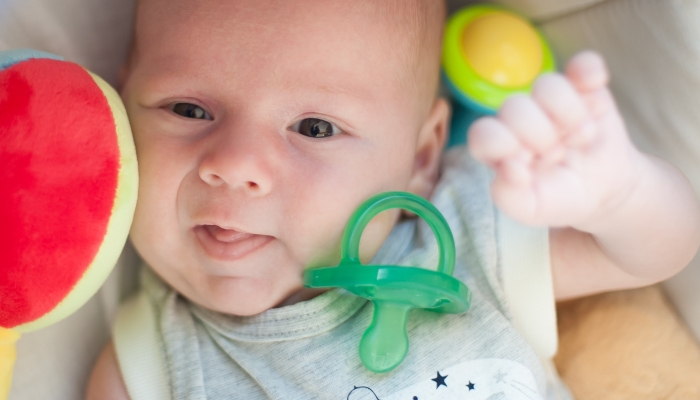
Are Pacifiers Safe for Babies?
As with any tool, toy, or product you use around your child, you need to monitor them and ensure they’re using it in its intended and safest form. Check out our list of the best pacifiers for your baby if you’re looking for high-quality, safe products.
Do’s and Don’ts of Pacifiers
There are some clear do’s and don’ts for safe pacifier use:
- Choose a one-piece, dishwasher-safe pacifier. Two-piece pacifiers pose a choking hazard.
- Introduce it, but don’t force your baby to use a pacifier.
- Clean your baby’s pacifier by running it through the dishwasher or boiling it to sterilize it (important for newborn babies up to 6 months old).
- After 6-months, you can simply wash your baby’s pacifier with soap and water. Avoid using your mouth to “clean” a pacifier for your baby. You will spread more germs that way.
- Don’t put any food or substances on your baby’s pacifier (one exception is putting a little bit of breast milk or formula when introducing it).
- Don’t use it as the first line of defense to soothe your little one. Try rocking your baby or patting their back to help calm a crying baby. Read more sleep training methods here.
- Offer a pacifier only after or between feedings or before bed.
- Replace your pacifiers regularly and use the appropriate size for your baby’s age. Watch for signs of breakage or deterioration of the material.
- Use caution with pacifier clips. Never attach a string or strap to a pacifier that’s long enough to wrap around your baby’s neck.
Reasons Why Your Baby Won’t Take a Pacifier
Pacifier aversion can occur when parents offer a pacifier too frequently or for the wrong cues.
Your baby usually cries for one of the following reasons: hunger, tiredness, dirty diaper, wants affection, colicky, sick, hot or cold, and other circumstantial reasons.
If you offer a pacifier every time your baby has an issue, they’ll associate it with frustration because it didn’t provide a solution. This may teach your baby to actually reject the pacifier and never want to try it again.
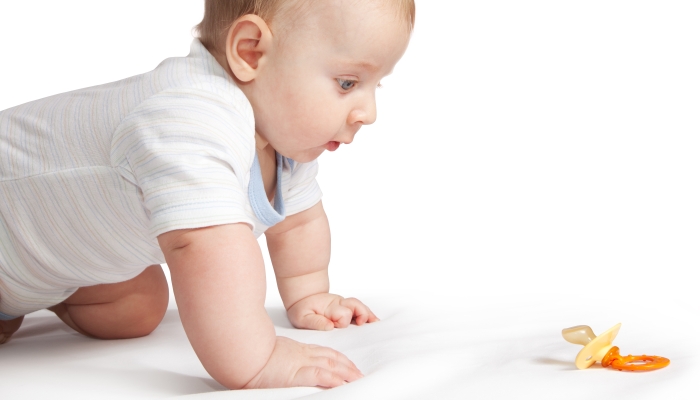
How to Get Your Baby to Take and Keep a Pacifier
Here are some simple tips to help your baby want to take and keep in her pacifier.
Start by introducing it to your baby for fun. This is a bit of a reverse psychology tactic. You’ll briefly introduce it to play with and pique her interest, then put it away for a while.
Offer it after feeding and try coating it in breast milk or formula to entice your baby.
Offer it when your baby is sleepy or if your baby is colicky. Most importantly, have patience! Leave it alone for a while if your baby refuses or spits it out immediately.
Read this article for more information on how to keep a pacifier in your baby’s mouth.
Should You Force Your Baby to Take a Pacifier?
Never force your baby to use a pacifier. If the pacifier falls out of your baby’s mouth during the night and your baby doesn’t notice, don’t put it back in.
Also, there is no risk for babies who never come around to using pacifiers. Some children never take to pacifiers, and that’s ok. If your child isn’t into it after a few tries, it’s fine to put it away for a few weeks and try again later.
How to Soothe Your Baby Without Using a Pacifier
If you’re struggling to get your baby to take a pacifier, you can try some of these soothing methods:
- Many babies like sucking on a muslin cloth blanket or burp towel
- Snuggling a stuffed animal or teething toy
- Gentle rocking and patting on your baby’s back
- Humming and singing to your baby
- Bouncing your baby on a yoga/exercise ball
- White noise machines
- Breastfeeding
For more tools, you can read about solutions for an overtired baby and an overstimulated baby.
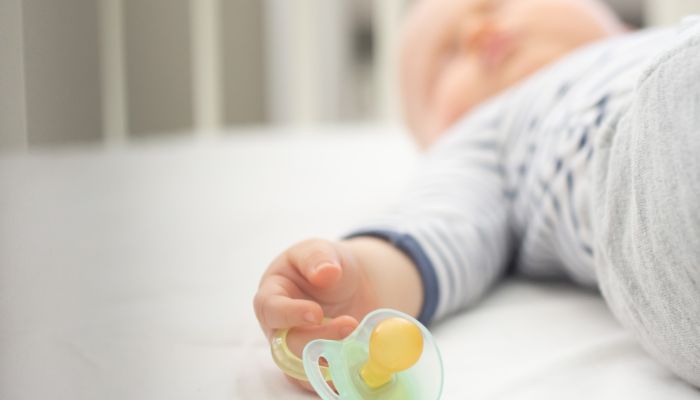
FAQs
How Common is Pacifier Use?
According to an American Family Physician study, about 60 to 85% of infants in western countries use pacifiers.
How Long Does Pacifier Withdrawal Last?
If you’re worried about the weaning process and how long it lasts, it’s usually not more than a couple of days. Within two weeks, all signs and symptoms of pacifier need and tantrums will be gone.
When is the Best Time to Wean a Baby from a Pacifier?
The risks of pacifier use begin to outweigh the benefits as your baby gets to around two years old. Between two and four years is when pediatricians recommend breaking the habit. If your child has difficulty giving up his pacifier, talk to their doctor or dentist for additional resources.
Why Can’t My Baby Keep a Pacifier in His Mouth?
There are many possible reasons for this—one of the easiest is to check if the pacifier is the right size. Many parents are surprised to discover that pacifiers come in different sizes for different-sized babies’ mouths.
If your baby is physically struggling to chew and suck on it or repeatedly spits it out, the pacifier could be too large or too small.
The package of your baby’s pacifier should state the intended size of the infant to use it. Inspect your baby’s pacifier regularly to ensure that it’s not wearing, tearing, or breaking down and possibly causing physical discomfort.
How Can I Get My Breastfed Baby to Take a Pacifier?
A common complaint from breastfeeding moms is that their babies play around and try to use their breasts as pacifiers and will often reject a real pacifier.
It can be tricky to get babies to take a pacifier when they’re used to breastfeeding and have a strong preference for the comfort of their mother.
However, because of the many benefits of breastfeeding, many mothers choose to wait 3-4 weeks to introduce pacifiers to their infant – just in case their baby will struggle with breastfeeding if given a pacifier too soon.
For babies new to breastfeeding, nipple confusion can result in breast refusal. Or breastfeeding issues like poor latching or a less efficient sucking technique (that can also be painful for mom.)
Whether your little one comes around to taking a pacifier or never does, what’s important is offering many solutions for them to self-soothe. See what your child gravitates toward and follow their interests.
Many babies will use pacifiers for a few months and then lose interest. Others can latch on to them and struggle to give them up.
Your child’s pediatrician and dentist will check for any teeth or oral issues from pacifiers early on. Make sure they go for regular check-ups. Don’t hesitate to contact your child’s physician for additional resources if you’re concerned about their pacifier habit.
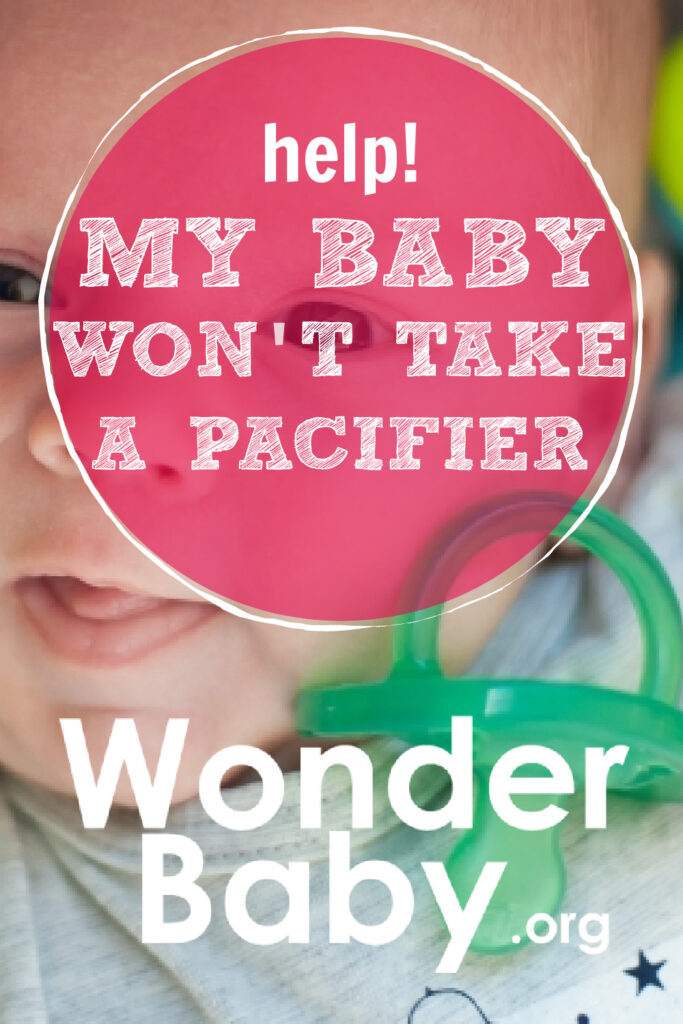
Related Posts
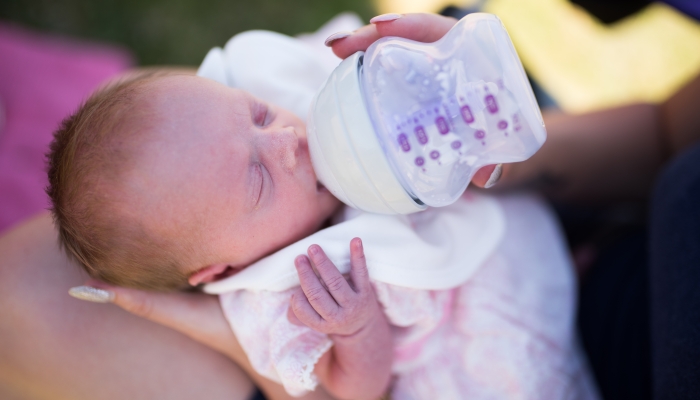
Feeding and Eating, Special Needs
Feeding Therapy Approaches for Infants with Special Needs
Many children with special needs have feeding difficulties. Working with a speech therapist, being patient, and experimenting with textures can help.

Feeding and Eating
Unexpected Foods That Cause Allergen Cross-Reactivity
A variety of unexpected foods and environmental substances can trigger an allergic reaction through cross-reactivity to food proteins.

Feeding and Eating
Easing Anxiety for Families Facing Food Allergies
Ongoing physical preparations and speaking openly about anxiety can ease the transition from diagnosis to living well with a food allergy.